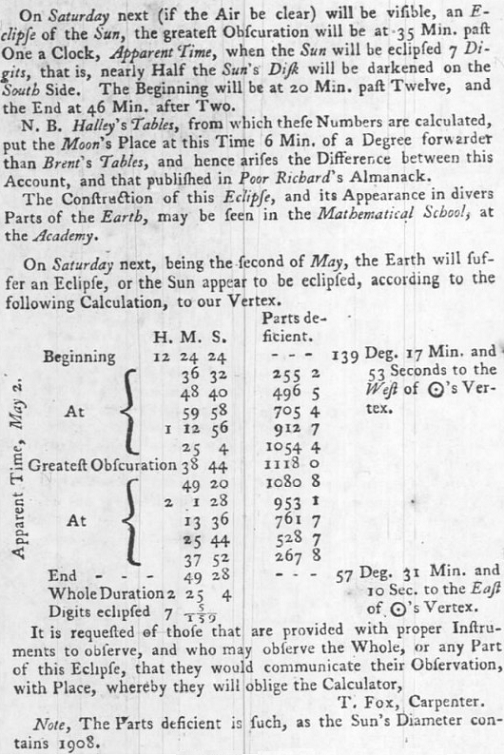Pennsylvania Gazette - April 30, 1752
Eighteenth century newspaper accounts of solar eclipses are relatively rare and when they do show up they're usually just short blurbs about local circumstance details taken from the almanacs of the day. However, the brief notice printed in the Pennsylvania Gazette about the total eclipse of May 13, 1752, which ran through Spanish-controlled Mexico and Florida, is unusual. The notice was submitted to the paper by a T. Fox, a Philadelphia carpenter, who claims that the times published for the 50 percent partial eclipse in Philadelphia by Benjamin Franklin's Poor Richard's Almanack are incorrect and that he himself has calculated the correct times. And indeed, with the benefit of today's precise eclipse predictions, we can see that Franklin's times were off by about 15 minutes and Fox's times are just about perfect (although it's unclear why Fox's chart doesn't correspond to the correct times he references in his opening paragraph). Incidentally, the newspaper refers to the eclipse as occuring on May 2, not May 13, because Great Britain and her colonies wouldn't finally switch from the Julian calendar to today's Gregorian calendar for another four months.
(Any information about eclipse viewing procedures provided in historical articles should be considered unsafe)
On Saturday next (if the Air be clear) will be visible, an Eclipse of the Sun, the greatest Obscuration will be at 35 Min. past One a Clock, Apparent Time, when the Sun will be eclipsed 7 Digits, that is, nearly Half the Sun's Disk will be darkened on the South Side. The Beginning will be at 20 Min. past Twelve, and the End at 46 Min. after Two.
N.B. Halley's Tables, from which these Numbers are calculated, put the Moon's Place at this Time 6 Min. of a Degree forwarder than Brent's Tables, and hence arises the Difference between this Account, and that published in Poor Richard's Almanack.
The Construction of this Eclipse, and its Appearance in divers Parts of the Earth, may be seen in the Mathematical School, at the Academy.
On Saturday next, being the second of May, the Earth will suffer an Eclipse, or the Sun appear to be eclipsed, according to the following Calculation, to our Vertex.
Apparent Time, May 2.
|
H. |
M. |
S. |
Parts deficient. |
| Beginning |
12 |
24 |
24 |
[1] |
|
|
36 |
32 |
255 2 |
|
|
48 |
40 |
496 5 |
| At |
|
59 |
58 |
705 4 |
|
1 |
12 |
56 |
912 7 |
|
|
25 |
4 |
1054 4 |
| Greatest Obscuration |
|
38 |
44 |
1118 0 |
|
|
49 |
20 |
1080 8 |
|
2 |
1 |
28 |
953 1 |
| At |
|
13 |
36 |
761 7 |
|
|
25 |
44 |
528 7 |
|
|
37 |
52 |
267 8 |
| End |
|
49 |
28 |
[2] |
| Whole Duration |
2 |
25 |
4 |
|
| Digits eclipsed |
7 |
5/159 |
|
|
[1] 139 Deg. 17 Min. and 53 Seconds to the West of ☉'s Vertex.
[2] 57 Deg. 31 Min. and 10 Sec. to the East of ☉'s Vertex.
It is requested of those that are provided with proper Instruments to observe, and who may observe the Whole, or any Part of this Eclipse, that they would communicate their Observation, with Place, whereby they will oblige the Calculator,
T. Fox, Carpenter.
Note, The Parts deficient is such, as the Sun's Diameter contains 1908.
